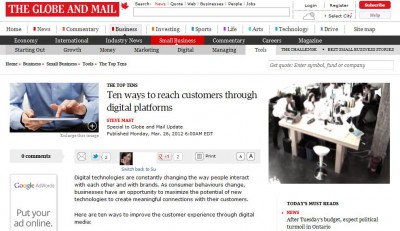 If you missed it earlier this week, here’s a look at Steve Mast’s article from The Top Tens section of Monday’s Globe and Mail.
If you missed it earlier this week, here’s a look at Steve Mast’s article from The Top Tens section of Monday’s Globe and Mail.
“Ten ways to reach customers through digital platforms”
Digital technologies are constantly changing the way people interact with each other and with brands. As consumer behaviours change, businesses have an opportunity to maximize the potential of new technologies to create meaningful connections with their customers.
Here are ten ways to improve the customer experience through digital media:
1. Integrate social media intelligence into traditional customer insight. Social and digital technologies provide an unprecedented opportunity to gain insight into what customers are saying, doing and sharing. Brands that are establishing social listening strategies can gain a deeper understanding of their customers’ wants and needs and have the ability to take the pulse of their overall brand health and customer satisfaction.
2. Develop an online customer advisory community. Digital provides a multitude of ways to gather customer feedback, ideas and opinions. One way to leverage your customer base is by developing a closed Market Research Online Community (MROC) to ask your customers their opinions and thoughts on new product ideas and service options.
3. Develop an online idea forum or crowdsourcing engine. Crowdsourcing is not just a buzzword. Brands like Starbucks, American Express and Dominos Pizza are leveraging online communities to generate customer ideas through programs like My Starbucks Idea, American Express OPEN Forum and Think Oven. The Next Great Innovator challenge, developed by RBC Royal Bank to source ideas for innovative banking products and services from Canada’s youth, is another great example.
4. Mobile engagement. First and foremost, creating a mobile-friendly website is key to engaging customers on this platform. Leveraging location-based services like FourSquare is another great way to engage customers and build brand loyalty.
5. Embed digital experiences into the physical space. The adoption of 2D barcodes by brands is one example of engaging customers at a store level. Other examples such as touchscreen technology, image recognition, augmented reality and even the adoption of Microsoft Kinect are all examples of embedding digital into the physical space.
6. Develop branded content. Capturing the attention of your customers and engaging them with your brand has never been more challenging. Companies need to find more interesting ways to hold their customers’ attention. Gamification is one such phenomenon. Brands like Nike are using gaming techniques to build engagement and loyalty through apps like the Nike Training Club, an exercise app that rewards users with workout badges and by giving them access to exclusive training sessions from professional athletes, celebrities and even Rihanna’s personal trainer.
7. Engage customers in a dialogue. Customer ratings and reviews is nothing new as part of ecommerce. However, this is just one way of engaging customers in a two-way dialogue. The integration of a blog, Facebook and Twitter feeds into your websites are all great examples of creating a dialogue with consumers.
8. Incorporate mobile payment systems. One of the hottest and most talked-about mobile technologies is mobile payments and micropayments. The growth of chip card technology in credit cards and mobile payment applications like the Starbucks Card Mobile App has opened up new ways for brands to provide payment systems to their customers. However, keeping in mind the customer experience, providing too many options to pay can overwhelm your customers.
9. Enhance the second screen experience. With the growth of tablets and other smart devices, brands now need to consider customers having a multi-screen experience. Understanding how customers move between these different screens is important to define each of their purposes. Manulife Financial’s new CoverMe™ Travel Mobile Site and Packing App illustrates how an insurance company can use smartphones to provide an additional valuable service to its customers.
10. Implement new near real-time customer service channels. The need to provide near real-time customer service channels is now becoming a standard or a must with any brand. JetBlue is a great example of a company using its Twitter account as a customer service channel to help shorten waiting times and to deal with frustrated customers immediately.
Steve Mast is President of Delvinia, a Toronto-based digital strategy and customer experience design firm dedicated to helping its clients in the financial, media, education, retail and technology sectors craft effective digital solutions anchored in customer behaviour.